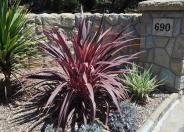
Common name:New Zealand Flax
Botanical name:Phormium tenax
New Zealand Flax is a large, bold plant with stiffly vertical, sword-like, green leaves that arise from its base. It should be grown under full sun for best color. Varieties will offer different growth habits and leaf color.

Common name:Ribbonleaf Japanese Maple
Botanical name:Acer palmatum 'Atropurpureum'
This Japanese Maple grows as a small, deciduous tree complete with palmate leaves that turn red and endure for the entire season.

Common name:Monarch Blanketflower
Botanical name:Gaillardia grandiflora 'Monarch'
Gaillardia gra. 'Monarch' is a perennial. Grows to 2-4 ft. high, 1.5 ft. wide, with roughish gray-green foliage and single or double flowers 3-4 in. across. Exceptionally long bloom.

Common name:Amazing Red Flax
Botanical name:Phormium 'Amazing Red'
Phormium 'Amazing Red' is an evergreen perennial. Big, dramatic plant composed of many swordlike, stiffly vertical leaves in a fan pattern. Flowers stems reach high above leaves, bearing clusters of 1-2 in. blossoms in red.

Common name:Santa Barbara Daisy
Botanical name:Erigeron karvinskianus 'Profusion'
This herbacious perennial quickly grows to 1' tall and 3' wide. White daisy-like flowers with gold centers bloom heavily in spring and fall in the low desert but in higher elevations, bloomtime is only during the summer. The foliage is hairy and gray green. It does better in light shade if planted in the low desert. This plant attracts butterflies. It looks great in rock gardens, crevices, on walls, borders, containers, hanging baskets. It tolerates sand and wind; it does best with well draining, moist soil.
The natural world works in cycles. Everything is changing form and moving from place to place in an endless energy exchange system. The leaves and twigs that fall to the ground, not to mention other life forms that might die, decompose and combine with water, air and minerals of the soil to create a medium for future plants.
Click in the green box for more information
Designer:
Photographer: GardenSoft
Incorporate compost 6" into your soil to retain water, reduce compaction, feed earthworms, and provide valuable nutrients to your plants.
Adjust sprinklers to avoid watering sidewalks and driveways.
Develop healthy soil for plants that are vigorous and naturally pest-resistant.